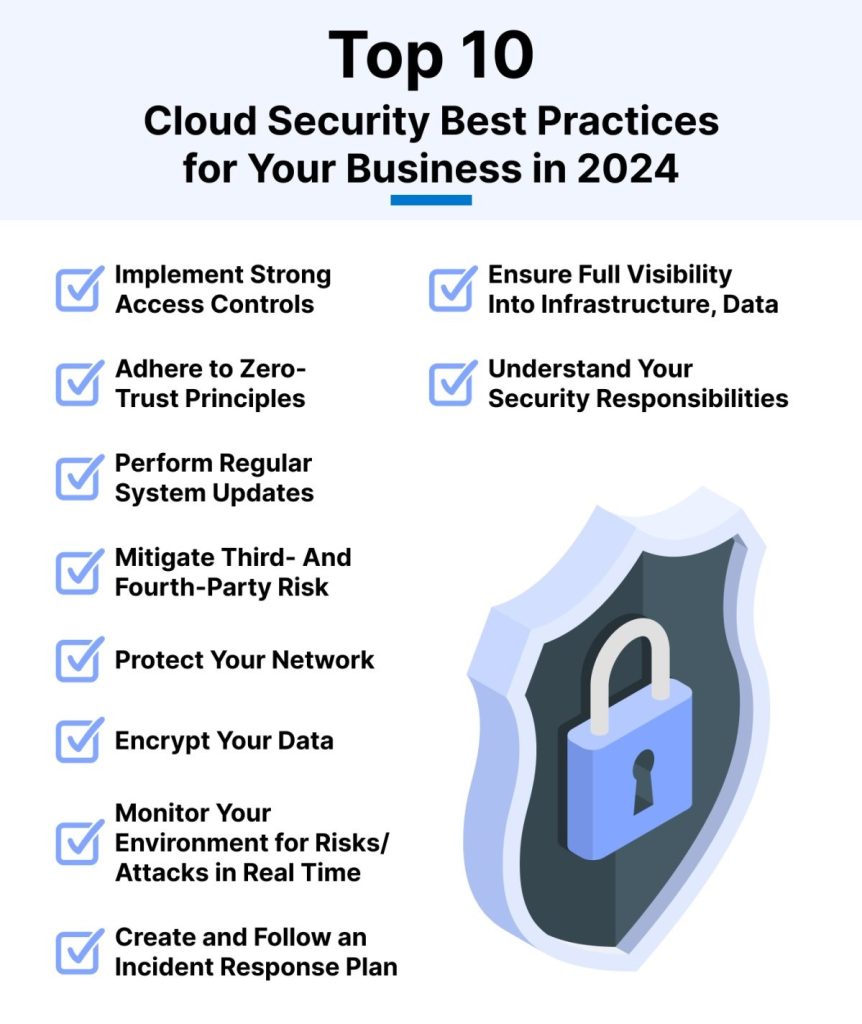10 Cloud Security Best Practices 2024: Expert Advice Free
As more businesses transition to the cloud, it's essential to prioritize the protection of their infrastructures, corporate data, and customer information. Beyond selecting a reputable web hosting provider, companies must adopt proactive measures to secure their operations. Here, we delve into the top 10 cloud security best practices and expert tips to help organizations fortify their cloud-based systems.
Key Takeaways
Implementing robust access controls and strict encryption protocols are among the best practices that enable companies to enhance the security of their cloud-based solutions. Adhering to cloud security best practices strengthens security postures and reduces risks. Neglecting these measures leaves companies susceptible to cyberattacks.
1. Enforce Strong Access Controls
Access control is vital for cloud security. Organizations should implement a mix of physical and logical access controls and multifactor authentication to limit access to sensitive data and resources. Taylor Dolezal, head of ecosystem at the Cloud Native Computing Foundation, emphasizes that this reduces the risk of data breaches by ensuring only authorized individuals can access critical assets. Adopting the principle of least privilege further enhances security by restricting access to only necessary resources for specific roles.
Srini Kadiyala, CTO of OvalEdge, highlights that poor access control remains a significant cloud security issue. Effective data access policies and controls are paramount for securing cloud data. Access controls should ensure that only users with explicit permissions can access certain data assets.
Hardy Desai, founder and CEO of Supple Digital, stresses the importance of stringent access controls for their digital marketing agency, which manages thousands of sensitive documents. A dedicated team ensures document access, privileges, and cloud security are consistently monitored and updated.

2. Adhere to Zero-Trust Principles
Rodman Ramezanian, global cloud threat lead at Skyhigh Security, asserts that cloud security in 2024 will demand adherence to zero-trust principles, emphasizing security at the edge and leveraging AI for enhanced threat detection and system auditing. Traditional access management solutions often create frustration, whereas a zero-trust approach, as suggested by Sundaram Lakshmanan of Lookout Inc., considers device health and user experience when granting access.
Jim Alkove, co-founder and CEO of Oleria, adds that zero trust assumes no user, including senior executives, is inherently trustworthy, necessitating strict verification and continuous validation of users, devices, applications, and networks.
3. Perform Regular System Updates
Maintaining a secure cloud environment requires continuous vigilance. Regular system updates, patch management, penetration testing, and vulnerability assessments are critical practices to identify and address potential vulnerabilities. Roman Zrazhevskiy, founder and CEO of MIRA Safety, emphasizes the importance of regular security system updates and customer data backups to ensure the latest security protocols and effective damage control in case of a breach.
4. Mitigate Third- and Fourth-Party Risk
As organizations collaborate with third and fourth parties, digital supply chain security becomes crucial. Nataraj Nagaratnam, IBM Fellow and CTO for Cloud Security at IBM highlights the need for a holistic approach to hybrid cloud cybersecurity strategies. This includes adopting risk management solutions to gain visibility into third- and fourth-party risk postures and achieving continuous compliance.
Enterprise technology analyst David Linthicum stresses the importance of vetting and monitoring third-party cloud service providers to ensure they meet security standards and align with organizational requirements.
5. Protect Your Network
Implementing intrusion detection systems, firewalls, and other network security measures is essential to guard against unauthorized access. David Linthicum recommends these measures to protect cloud-based systems, particularly given the vulnerabilities of using the open internet.
6. Encrypt Your Data
Encrypting data is crucial for protecting sensitive information such as customer data and intellectual property. Sean Tilley, senior director of sales at 11:11 Systems, explains that encryption ensures data security during transit and storage, allowing organizations to securely share data while maintaining control over access. Encrypted data is also less vulnerable in case of a breach, as attackers would need encryption keys to decrypt the information.
7. Monitor Your Environment for Risks/Attacks in Real Time
As cyberattacks become more sophisticated, Tomer Filiba, CTO at Sweet Security, emphasizes that static solutions are insufficient. A runtime (agent-based) solution is necessary to monitor workloads, detect incidents in real time, and respond effectively, providing better investigative abilities.
8. Create and Follow an Incident Response Plan
Having a robust incident response plan is crucial for efficiently addressing and mitigating cloud security incidents. David Linthicum advises regular testing of the plan to ensure preparedness. Dmitry Dontov, founder and CEO at Spin.AI, emphasizes the importance of 24/7 proactive monitoring and alerting, as well as automated data recovery in case of an attack.
9. Ensure Full Visibility Into Infrastructure and Data
Tim Potter, principal at Deloitte Consulting LLP, stresses that full visibility into your technology infrastructure and data is essential for protection. Unmonitored systems and infrastructure often lead to security breaches. Investing in vendor solutions to gain comprehensive visibility is recommended for effective security management.
10. Understand Your Security Responsibilities
Steve Tcherchian, CISO at XYPRO.com, highlights the misconception that cloud providers assume full responsibility for security. Companies must understand their specific security responsibilities and familiarize themselves with the best practices and documentation provided by cloud providers like AWS, Microsoft Azure, and Google Cloud to implement proper security configurations.
The Bottom Line Cloud Security Best Practices 2024
Adhering to these cloud security best practices will help strengthen your security posture and mitigate risks. Protect your cloud-based systems by leveraging insights from top industry experts to stay ahead of potential threats and vulnerabilities.
Comments (0)